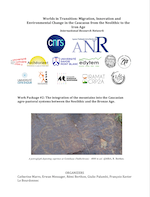
Worlds in Transition: Migration, Innovation and Environmental Change in the Caucasus from the Neolithic to the Iron Age. Work Package #2 - The integration of the mountains into the Caucasian agro-pastoral systems between the Neolithic and the Bronze Age.
- Du 9 au 11 novembre 2020, Online
Workshop organisé par C. Marro (Archéorient), E. Messager (Edytem UMR 5204), R. Berthon (AASPE UMR 7209), G. Palumbi (CEPAM UMR 7264), F.-X. Le Bourdonnec (IRAMAT-CRP2A UMR 5060).
>>>Programme - site du workshop
>>> Abstracts (.pdf)
Mountains in the Caucasus are characterized, as elsewhere, by their wealth in natural resources. Apart from pasturelands, the Lesser Caucasus mountain ranges are famous for their variety in mineral resources that include obsidian and copper beds, lead, silver and gold deposits and salt. The region is also rich in water springs.
Some Caucasian communities started to develop a Neolithic way of life at the end of the 7th millennium BCE, but we still do not know whether the Neolithic expansion reached the mountainous territories from the onset. In particular, the beginnings of pastoral nomadism and vertical mobility are still debated issues: several Neolithic settlements have been excavated in the valleys and the steppes of the Kura and Araxes basins (Aratashen, Aknashen and Mokhra Blur in Armenia, Arukhlo and Gadachrili Gora in Georgia, Göytepe, Mentesh Tepe, Kamil Tepe, Ismailbeytepe, Haci Elamxanli in Azerbaijan and Kültepe I in Nakhchivan), but apart from the cave sites of Bavra in Georgia and Damjili in Azerbaidjan, no Neolithic site has so far been found in the mountains, which suggests that mountain milieux were integrated into village economies only in a second step. An alternative explanation could be linked to the rarity of archaeological surveys so far carried out in the mountains, or to the difficulty in identifying Neolithic sites specific to mountains territories.
While this question remains debated for the Neolithic period, agro-pastoral systems seemingly started to expand towards the mountains from the Chalcolithic onwards (ca. 4700 BCE). The occupation of the uplands probably went through different exploitation modes, as suggested by the evolution of settlement patterns in the valleys and the steppes across the Kura and the Araxes basins. A major rupture in the socio-economic system probably occurred at the end of the 3rd millennium, which led to the abandonment of most low-altitude settlements across the highlands, including Eastern Anatolia. This evolution was correlated with increasing activities in mountainous territories, where cemeteries and kurgans multiply from the beginning of the Middle Bronze Age onwards (ca. 2200 BCE), suggesting the reinforcement of a pastoral nomadic lifestyle.
The aim of WP#2 will be to discuss the beginnings and the exploitation modes of the mountains by valley communities, with a view to studying the evolution of subsistence strategies and the interactions between the highlands and the lowlands from the Neolithic onwards. Three main themes will be addressed during a three-day on-line workshop (9th-11th November, 2020):
- The beginnings of vertical pastoralism in the Caucasus (November, 9th)
- The formation and development of mountain communities (November, 10th)
- Mobility and the exploitation of natural resources (November, 11th)